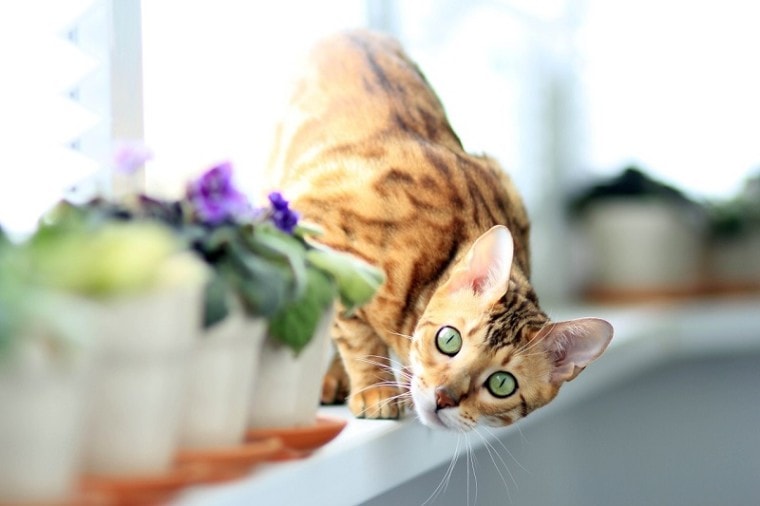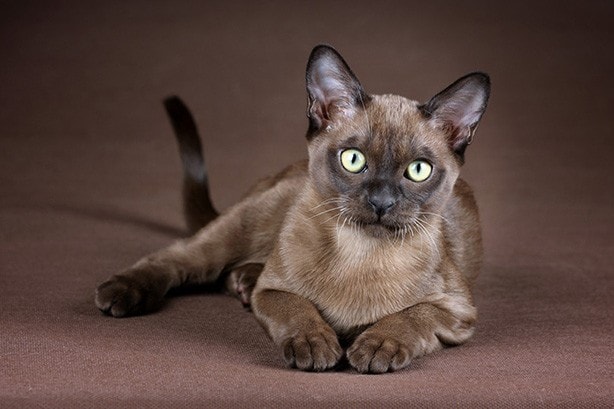
The cat’s close relationship to humans is marked by its existence in countless idioms and sayings. We let the cat out of the bag, take a cat nap, say there is more than one way to skin a cat, put the cat among the pigeons, curiosity killed the cat, etc. But one of the best-known idioms refers to the fact that cats are said to have nine lives. This isn’t true, but the saying likely originates from the fact that cats have an innate ability to survive dangerous situations and get away by the skin of their teeth.
But why are there nine lives specifically? And is there any truth to the saying? Let’s take a closer look.
A Cat Always Lands on Its Feet
This saying refers to the fact that cats have an innate ability to survive, even when they are put in dangerous situations. They are biologically built to withstand challenges.
They have a compact body and a low center of gravity. This means that their body naturally wants to land feet side down, and they have a righting ability that further accentuates this. The result is that if a cat falls from a high space, it will almost always land on its feet.

The Righting Reflex
A cat’s righting reflex actually starts to develop at around 4 weeks of age. By 7 weeks, the ability is perfected and it means that your feline friend can twist its body in mid-air to right itself. This is possible because the cat’s spine is more flexible than that of other animals.
Not only can the vertebrae move up and down, but they can twist. They are also supported by cushioned disks, which act like shock absorbers that take the strain of a hard landing. Cats do not have a clavicle, or collarbone, which means that they can retain even more of an articulated style when in motion.
A cat needs a minimum of 30 cm for this self-righting mechanism to work fully. If they fall from a shorter height than this, they could still land on their back or side, but the risk of damage is minimal.
Narrow Gaps
The lack of a clavicle also enables cats to squeeze through narrow spaces, and this is another way in which the species may appear to have nine lives. When they are being chased by predators and larger animals, they can squeeze through small gaps and make a narrow escape.
As well as the lack of a clavicle and a flexible spine, cats also have their whiskers to aid in this way. A cat’s whiskers are highly sensitive. They use them as a measure of the width and breadth of their body. They can tell whether their body will fit between a gap by whether their whiskers will fit.

The Tail of Balance
The tail is another tool in the cat’s survival arsenal. In this case, it helps with balance. Cats love to walk along walls and even fences. They like to climb trees, and they get themselves into elevated positions on some very narrow ledges. The knowledge that they will land on their feet may give them the confidence to tackle such positions, but so too does their tail.
A cat’s tail provides balance, which is why if you’ve ever seen a cat losing balance while walking on a fence, it will quickly whisk its tail back and forth until it is steady once again.
Curiosity Killed the Cat
In order for a cat to show off its incredible ability to survive, it first needs to be put in positions where survival is required. Cats do love to investigate, hence the idiom “curiosity killed the cat.” This curiosity gets cats into positions where they have to rely on their whiskers, tails, and their self-righting mechanism to survive and is why people considered cats to even need more than one life in the first place.
Why Nine?
So, is there any significance to the number nine?
In truth, cats have exactly nine lives in some specific cultures. In Arabic culture, cats have seven lives, and in some Spanish-speaking nations, the poor kitties only have six lives.

Egyptian Gods
The number nine may originate from ancient Egypt. Cats were highly revered in Egypt, and it was believed that the sun god, Atum-Ra, not only took the form of a cat, but gave birth to eight other gods and, therefore, lived nine lives.
Nine Years
The old adage, “a cat has nine lives. For three he plays, for three he strays, and for the last three he stays” may also point to the fact that the original meaning of the phrase referred to nine lives as being nine years because this is how long cats used to live.
Modern domestic cats have an average life expectancy of around 15 years, but this hasn’t always been the case, and it is thanks to improved nutrition and better feline healthcare. Once upon a time, cats would have likely only lived for around 9 or 10 years.
Conclusion
Whether a cat has six, seven, or nine lives, and whether it refers to how long a cat lives or its incredible ability to avoid injury and accidents, it all points to the fact that we love our cats and continue to be fascinated by the things they do.
Related read:
- Understanding Essential Amino Acids in Your Cat’s Diet
- 11 Common Cat Allergies and Their Symptoms & Causes
- Scottish Fold
- Why Are Cats So Flexible?
- Do Cat’s Whiskers Grow Back? How Long Does It Take?
Featured Image Credit: Irina_kukuts, Pixabay







